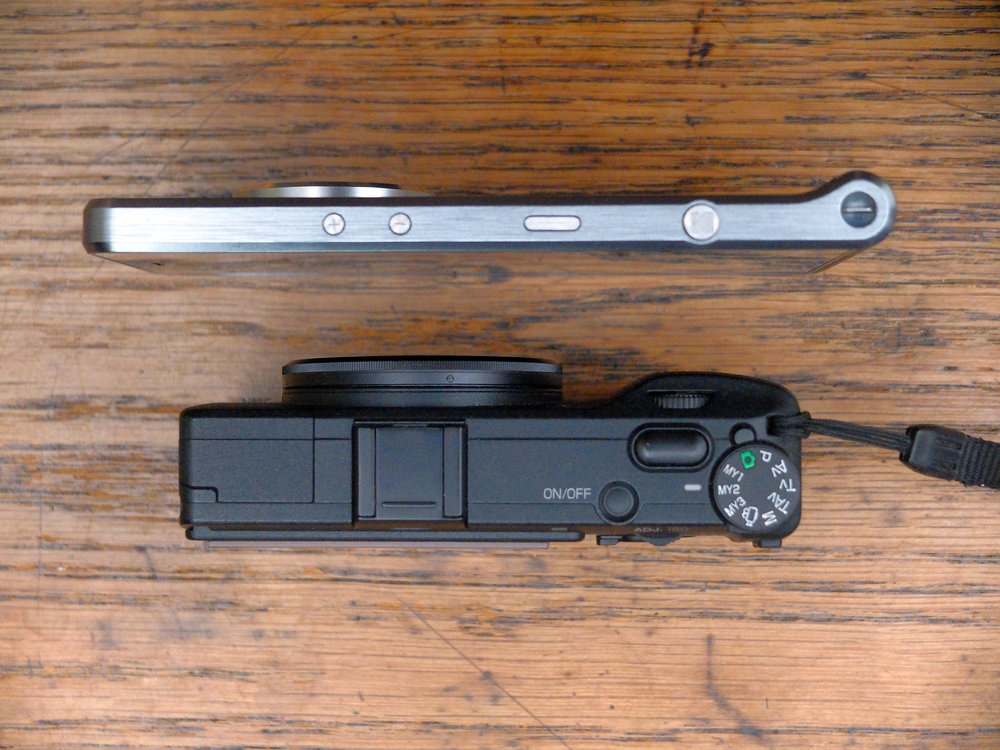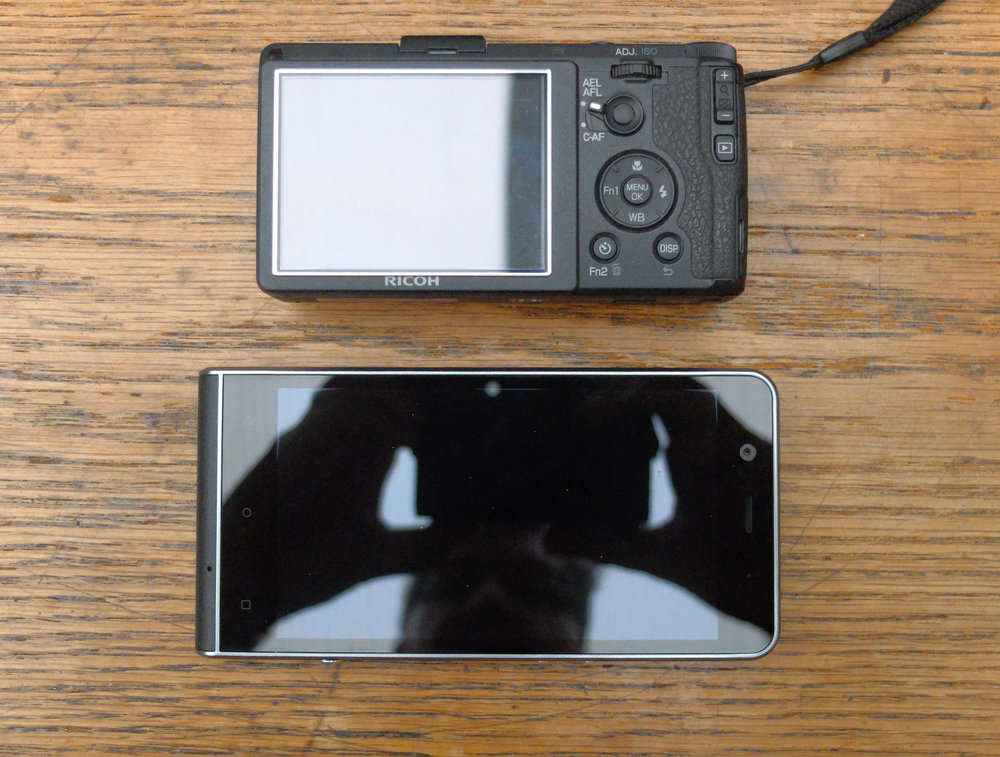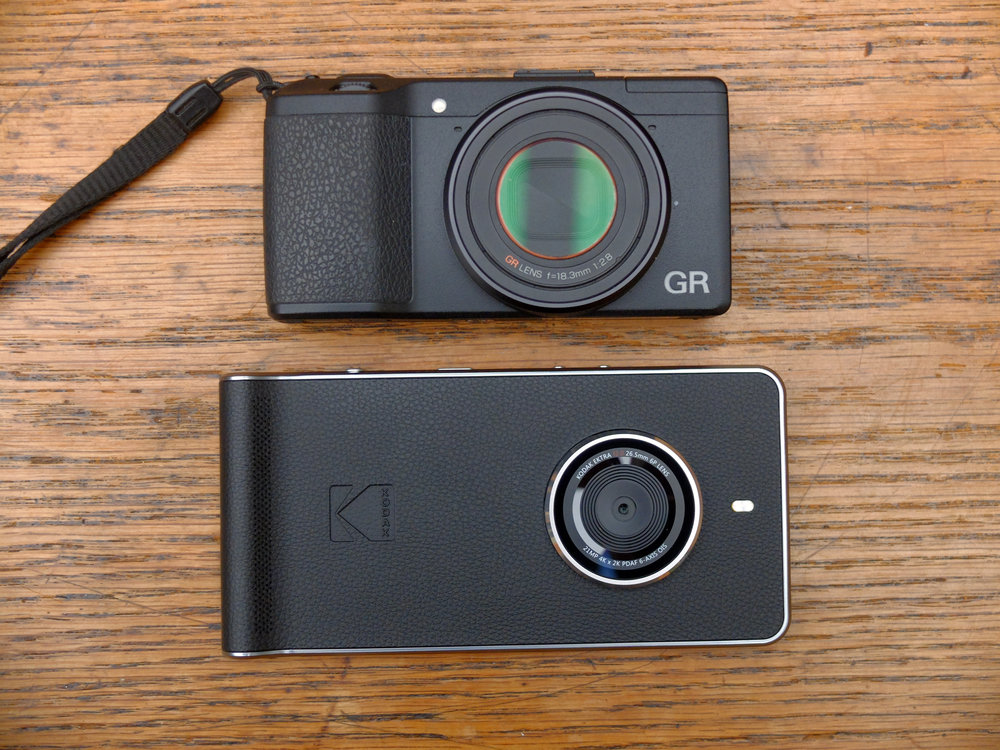This is the first of three articles on the subject of mobile phone photography. Let me set out my stall at the outset – I am in general not a fan of a camera built into a phone. Most remind me of the very first example of tech “convergence” I encountered in the early 1980s; I came across a curious beast one day in a branch of Dixons in Woking. On one side it was a four-function LED calculator, but flip it over and the other side was a dictaphone – marvellous! It was big enough to take standard cassettes, which meant that the whole unit was nearly as big and as heavy as the Filofaxes carried by the Next-suited “Yuppies” of the day.
Today’s mobile phones are just like that evolutionary dead-end I found in Woking all those years ago – fatally-flawed compromises. They will get there, of course, but they have way to go yet. As a flexible and capable photographic tool, most phones are on a par with a slab of thickly buttered toast, and about as easy to handle. Not one has a viewfinder, sensors are almost universally small, lenses frustratingly slow and wide-angled and offer a battery life akin to a mayfly on speed.

In their favour they are quick and convenient – but then, so is a Pot Noodle… You can snap’nshare within minutes, processing your new “masterpiece” with a handy app to add that crunchy mono look – or a dog nose.
This is the critical equation. In very simple terms today’s devices are PHONEcameras whereas what I am really seeking is a CAMERAphone.
Xperience
My current portable telephone is a Sony Xperia Z Ultra; I’ve had it for the thick end of three years now. It’s been back once, for a charging problem, which was resolved within a week. It’s getting a little long in the tooth so I have tried to replace it three times, but it keeps soldiering on, because no replacement I have tried so far comes up to scratch. I’m typing this article on it now. In photographic terms it has an eight megapixel camera, which to be honest I use 99.9% of the time just to snap the shopping list on the board in the kitchen.
In short I don’t rely on it as a picture-taking machine. On average, the actual camera that I carry most often is my Ricoh GR. It rides along in my bag or case, or on my belt in an old Leica 18509 leather case designed, I think, for the Minilux. So my phone and my camera are always with me. But wouldn’t it be great to have some real convergence and have a ‘phone that actually had a proper camera?
I have always said that I would not take a camera built into a portable telephone seriously until they produced one with a) a dedicated shutter release and b) a tripod socket. Said with tongue in cheek but with an underlying element of seriousness; until a phone is actually designed for a photographer it will never satisfy. I have never found one – until, I thought, now; how wrong could I be?
When I learned that Kodak were bringing out an Ektra smartphone I got a little more than mildly excited. After less than 24 hours of ownership it’s back in the box and headed back for a refund.

Target demographic
Here’s why.
I should be the target demographic. I am old enough to have fond memories of the Kodak brand. I am a keen photographer. As I have explained, I carry a camera everywhere. I regard cameraphones as a waste of time.
In the Kodak Ektra, if the advertising hype is to be believed, we are being offered something – presumably – designed from the ground up specifically with photographers in mind. It’s a nice looking piece of kit, with a dedicated shutter release (tick) and is powered by the reliable and familiar Android operating system (tick).
There’s a website that is long on hype and short on content. That was the first warning sign. The Ektra is billed as a “photography-first smartphone”. They go on to say, “It’s like nothing else…” Well, they’re dead right there.
It looks nice. It feels like a premium product, from the moment you open that evocative Kodak-yellow box. The only thing they could have done further to summon the ghost of glories past would have been the whiff of film wafting up as you lift the lid.
You take it out of the box and fire it up — it is almost fully charged, which is a pleasant surprise. Since it comes with NFC, setup is a doddle (after you have installed the firmware upgrade that it craves as soon as it connects to the outside world via wi-fi). I connected a charging cable (USB type C, irritatingly) and left it to do its thing for half an hour. I came back to find it happily humming to itself and sated with the 90-odd apps that I have to my name in the Play Store.
And there, my friends, is pretty well where the story ends. I can’t tell you how good it is as a phone. It should be okay, since it runs a fairly stock version of Android 6.0 Marshmallow, has a proven deca-core processor, 3GB of RAM, 32GB of memory (plus of course the ability to take MicroSD cards, Apple take note) and has a 5″ 1920×1080 HD display.
But.
Be-Beep

Let’s focus upon the camera.
You can turn it on with two presses of the dedicated shutter release — no need to negotiate security or anything. It reacts reasonably quickly to the demand to power up and the screen snaps into life. You half-press the shutter release and…
Be-Beep!
You are deafened by the AF bleep and blinded by the AF assist light. Silly me, you chuckle, and immediately go menu-diving to stop all that nonsense. While you are there, you turn the flash off, and fix the focus point. You twiddle with the on-screen “function dial” — this is about as useful as the proverbial on a bull. It’s like putting a virtual dial on the phone part to dial a number the old fashioned way instead of punching buttons. It’s just plain daft. It’s also slightly more sensitive than a hormonal One Direction fan and spins like a multi-directional roulette wheel. Still, by a process of trial and error — error — error — aargh — nearly — once more — success! you get the thing off green square mode and into manual and set it up as you want. You even find a control to turn off the shutter sound.
Ok, we are ready to try again. Slowly depress the shutter and…
Be-Beep!
Ok, keep your cool. There must be a way. Press the down volume button — ah, but of course you have set the up and down volume controls to work the digital zoom in camera mode. No problem, back out to the main phone screen and turn off the volume there. But you can’t, because you started it in camera mode… Ok, start again. Pop in your PIN and unlock the main screen. Turn down the volume. That’s the volume for the whole phone, of course, not just the camera, because there isn’t a dedicated sound control just for the camera, other than the faux shutter noise… Hope you don’t get a call when you forget to turn it up again after you’ve finished snapping, eh?
So.
Back we go. Fire up the camera once more. Slowly depress the shutter and… That bloody AF light again! I’m SURE I turned it off…
Hang on…
I’m SURE I took it off green square mode and into manual…
Spin the bloody wheel of fortune again – place your bets…
Back to manual after only three goes this time.
Slowly depress the shutter and…
My retinas are now indelibly burned by the whiteout of the AF light.
Suspicions are overtaken by realisation and the horrible reality. Let’s make doubly sure — turn off…
Turn on again…
Oo look — GREEN SQUARE MODE. The Ektra doesn’t stay set as you left it.
At this point I delved back into the menus, selected “Factory Reset” followed by “Damn right I’m sure”, wiped off the fingerprints, repositioned the screen and lens protectors and put it back in the box.
Here’s the thing.
Whoever designed the Ektra was not a photographer. I doubt that they have ever seen an actual camera, let alone used one. I suspect that they are somehow convinced that by making the Ektra look like a pastiche of an old camera — pictures of which they had Googled — it will sell like hot cakes to hipsters, and to nostalgic old farts who want a portable telephone that takes proper pictures.
The problem is that us nostalgic old farts are not stupid — I can’t speak for hipsters.
Furthermore, we tend to know how a camera should work. This doesn’t, by any reasonable measure, work as a camera. Fisher Price could have done a better job, and in the past they have. I can’t show you any results from the Ektra because it failed at the first hurdle — it is simply completely unusable as a photographic tool.
And while I’m on the subject, let’s just blow away a little marketing smoke and break some mirrors. It turns out that the only Kodak involvement in the Ektra is to lend their name, their logo and their yellow box colour. Their DNA, their mojo and above all their highly respected camera-making knowhow is nowhere to be found. The company that actually makes the Ektra is a UK-based “manufacturer” called Bullitt. In this case, and given the speed with which I have returned this woeful pastiche of a camera, a more appropriate film to have named themselves after would have been “Gone in 60 Seconds”.
My advice? Save your money. Don’t spend it on the Ektra, the very nadir of the once proud Kodak brand. In fact don’t spend it at all until someone actually manages to produce a camera that can take and make calls rather than a portable telephone with fevered delusions of photographic competence.
Postscript
There’s a postscript to this story. Under UK law, if you buy anything over the Internet or by phone or mail order, you have an absolute right to return the item within 14 days for a full refund. 99.9% of vendors make this a smooth and easy process because it is in their interests to do so and because it is customer service best practice.
What they do not do is provide no returns information on their website, requiring instead that you contact their customer service.
What they do not do is then ignore three requests to return the item for over three days.
What they do not do is then require the customer to fill in a long and tortuous email form with all the information they already have prior to organising a courier pick up, something which also had to be chased before being actioned.
What they do not do, having wasted a week with all of the faffing above, is then take a further leisurely 14 days to provide a refund.
Avoid.
In the next part of this series, I’ll introduce you to the follow-up to the Ektra – a Panasonic CM1. I’ll compare it to my trusty GR – can it tick my boxes? Tune in and find out!
_____________
-
You can find more from Bill Palmer at Lightmancer and at Instagram
- Subscribe to Macfilos for free updates on articles as they are published. Read more here
- Want to make a comment on this article but having problems? Please read this

What a pity you didn’t have the patience to persevere and actually use the camera properly. I make a living as a photographer and I think the Ektra is wonderful. A selection of photos I took with it will appear next month to illustrate a feature in a business magazine. This magazine has very high standards for reproduction in print and the Ektra passed with flying colours.
As an Apple user I found it a bit alien at first but soon got the hang of it. The dial that represents that on an SLR is tricky to use as an icon at the bottom of the screen. But double tapping it brings it up full screen and it takes only a moment to do that, tap the mode and dismiss it back to the corner.
I didn’t have a problem with it defaulting back to any particular mode either. As I use it as a photographic tool only, I simply switch it on to standby then whenever I need to take a picture, a press of the standby button means the camera app is there and ready to go in whatever mode I last used. There is no need to quit the app. If I then use Instagram to post the pic, I just go back to the camera app and put it on standby ready for the next time.
You might have got to use the modes a little more. I cannot speak highly enough of the Sport mode. Living on the side of a valley which sees regular RAF manoeuvres, I have never been able to capture the various aircraft and how close to the house they get. With Sport mode, I was able to capture a non-blurred Harrier on a sharp sky background and equally sharp trees in the immediate foreground. Taking it into Photoshop, the detail was lost on the jet, but as a picture to show what happened it was marvellous, especially as it was taken through glass.
As to your point about the Ektra not being built by Kodak, I am not sure that Kodak ever manufactured their own cameras, in the same way as Apple don’t manufacture iPhones and white goods are made by a few factories for many different suppliers.
It is a shame that you went to all this effort to not review the Ektra. You might have liked it. I find it beats the camera on my ‘portable computer’ (iPhone7) hands down and I never go anywhere without it.
How torturous! Makes you wonder why point and shoot cameras never came with a SIM card slot and a direct connection to social media via apps. I know quite a few folks who would gladly pay 20 bucks a month to use a real camera to stay in touch with friends.
That’s very well said. we get wifi of course, but that still involves two devices. It’s what I’m getting at in my point about PHONEcameras vs CAMERAphones. The current crop are misnamed at best and this "Kodak" is a miserable entry into a market that already contains far better.
SIMs take you into a whole other area of security and regulation, as well as the interests of the telecoms companies who control the communications networks. These issues all arose when motor cars started to be fitted with SIMs some years ago. You could, of course, have a camera with a micro SIM slot which could be fitted with a SIM from your local telecoms company with a data plan, roaming arrangements etc. However, at this stage the battle has been fought and won by the phone manufacturers. Leica has acknowledged this by getting into bed with Huawei. The problem with the Ektra phone seems to be that it is an incompetently designed device and that is inexcusable at this stage. In the future, stand alone cameras will be for the minority that really care about picture quality. The rapid pace of change could not have been predicted 20 years ago.
William
The Kodak name is also coming back here:
http://www.kodakalaris.com/en-us/about/press-releases/2016/kodak-alaris-reintroduces-iconic-ektachrome-still-film
There is hope for the old name yet!
William
The question here is, why? Who of today’s main smartphone buying public would buy a phone with the Kodak name unless it was going to give them everything they have with their existing phones and more. The quality of the smartphone images is generally secondary in most cases to the ability to upload to social media or share with friends and family. If it is a palaver to take the photos, then this falls at the first hurdle.
On a separate Kodak related note, I recently acquired 3 old Kodak Brownie cameras, including one in a nice Art Deco finish. I am waiting for the time and weather to shoot some Kodak Portra 120 film on the two older ones. It will be interesting to see if they can ‘restore’ the reputation of Kodak. I will report here if they work any way well.
William